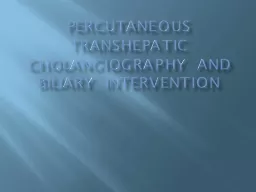

Cholangiography and Biliary Intervention Indications Treatment of malignant obstruction Adjunct to surgery Treatment of CBD calculi Treatment of benign strictures Diagnostic Failed ERCP Patient selection ID: 910651
Download Presentation The PPT/PDF document "Percutaneous Transhepatic" is the property of its rightful owner. Permission is granted to download and print the materials on this web site for personal, non-commercial use only, and to display it on your personal computer provided you do not modify the materials and that you retain all copyright notices contained in the materials. By downloading content from our website, you accept the terms of this agreement.
Slide1
Percutaneous TranshepaticCholangiography andBiliary Intervention
Slide2IndicationsTreatment of malignant obstructionAdjunct to surgery
Treatment of CBD calculi
Treatment of benign strictures
Diagnostic?
Failed ERCP
Slide3Patient selectionWHO performance statusImaging
Clinician/MDT discussion
Coagulation status
Ascites
Slide4WHO performance status0 – 2.In bed less than 50% of time
BSIR Audit report 2009, 19.8% in hospital mortality
15.6% in hospital mortality for benign disease
Audit of my procedures, 18% 30 day mortality
Patients with lower WHO performance status do better
Slide5ImagingUltrasound. Confirm biliary obstruction, mass, metastatic disease, calculi
CT. Confirm level of obstruction, mass, metastatic disease
MRI/MRCP. Complex biliary strictures, CBD calculi, liver metastases
ERCP. May have failed
Slide6Clinician/MDT discussion
Malignant or benign disease
Gastroenterologists
Surgeons
Radiologists
Other Healthcare Workers
Slide7Malignant DiseaseSurgical. ERCP and plastic stent or PTC and Internal/External biliary drainage
Palliative. ERCP or PTC and metallic Stent
Slide8Benign DiseaseERCP treatment of choicePTC and internal/external drain or plastic stent
. May enable successful ERCP later
Slide9Coagulation statusINR < 1.4. Consider vitamin K, FFP and also Beriplex/Octaplex. Contain prothrombin complex concentrate. Factors II, VII, IX and X as well as Proteins C and S
Platelets > 100,000. If less, consider platelet transfusion
Slide10ConsentWHO performance statusCheck coagulation
Explain procedure at least 1 day before
Risks. Bleeding, bile leak, infection, pneumothorax and failure
Slide11AnaestheticAnaesthetistGA
Discuss need for airway protection
Use LA
When applying for consultant post ask what access you may have to anaesthetics
Slide12AntibioticsAt start of procedureGentamicin 240 mg IV
Metronidazole 500 mg IV
Discuss with Microbiology
Slide13EquipmentUse what works best for you
Chiba needle 22 gauge
Trochar needle 18 gauge
NEF set
Stiff Terumo wire
Amplatz wire
Catheters. BMC and straight
Self expanding stent
Internal/External drains 8.5/10.5F. Discuss with your surgeon
Slide14Approach/Technique 1Ascites present? Drain first
Ultrasound?
Right lobe. Mid axillary line. Aim for xyphisternum.
Left lobe. Locate with U/S and usually aim for segment III.
Very gently inject 1/3 strength contrast (100) as needle is withdrawn
Duct entered when contrast flows away from needle and persists
Duct not entered. Change angle and try not to exit liver capsule
Duct normally anterior to portal vein
Slide15Approach/Technique 2Pre-surgery for cholangiocarcinoma. Discuss lobe to drain. Usually the lobe being preserved.
Pre-surgery for pancreatic cancer. Right lobe puncture.
Palliative. Drain right, left or both?
1. Chiba needle to opacify ducts then choose duct for trochar puncture and wire etc.
2. NEF set. Single puncture then wire, dilator and access sheath
Consider bile for cytology if no diagnosis
Slide16Approach/Technique 3
Stiff Terumo to cross lesion. Use pin vice for torque
Straight catheter
Amplatz wire
Dilator
Stent/Drain
1 or 2 stage procedure?
Temporary drain following stent?
Plug track? Coils, gelfoam etc.
Technical success >95% (BSIR audit)
Slide17Approach/Technique 4Unable to cross stricture, establish external drainage (8.5F internal/external drain). Further attempt after decompression usually successful.
Care with drainage bag essential
.
Internal external drainage, try not to use bag and bung catheter.
Slide18BSIR Audit. Mortality & Complications (reported)
In hospital mortality 19.8%.
Death or major complication 21.2% overall, 18.3% benign, 21.7% malignant.
Major complications in 7.9%, haemorrhage 3.5%, renal failure 1.8% and sepsis 1.6%.
Minor complications in 26.0%, pain 14.3%, sepsis 7.7% and haemorrhage 4.5%.
Association with ascites, elevated INR and low platelets.
1 year survival <20% for malignant disease.
Drainage more effective if stents placed across ampulla
Slide19BSIR recommendations1. Further audit of this cohort is required to determine cause of death and to demonstrate whether or not there are significant associated risk factors.
2. Given the high mortality in this group of patients further data collection will be required. Significant improvements in data completeness are required. Data submission remains voluntary, but NHS services should consider how they can make resources available to support data collection for individual operators
Slide20Case 186 yr female presented with sepsis and subsequent jaundice
Arteriopath
but otherwise reasonably fit
CT
Slide21Slide22Case 1Abscess right lobe liver drained Antibiotics
MDT discussion, for palliation
ERCP, failed to stent due to large duodenal diverticulum
PTC
Slide23Slide24Case 269 yr male with obstructive jaundiceCT, operable mass in head of pancreas
MDT discussion
Surgical candidate
ERCP to place plastic stent failed
PTC
Slide25Slide26Slide27Case 375 yr female with obstructive jaundiceCT, large central liver mass, likely cholangiocarcinoma. Further deposit in segment II
MDT discussion, not operable, palliative
PTC and stent left lobe
Slide28Slide29Slide30Case 471 yr maleMetastatic colorectal cancer
Multiple liver resections
Jaundice with recurrent liver and peritoneal tumour
Considering further chemotherapy
CT Small residual liver with mild duct dilatation
ERCP failed
Slide31Slide32Slide33Case 559 yr female with inoperable cholangiocarcinoma
Previous ERCPs with plastic and finally recently metal stent into left lobe
Recurrent jaundice
?percutaneous options
Slide34Slide35Slide36Take Home PointsCareful patient selection after MDT discussion
“Appropriate” Anaesthesia
Try not to use external
drainage bags